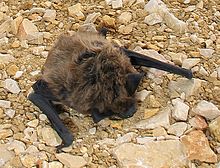Alpine bat
| Alpine bat | ||||||||||||
|---|---|---|---|---|---|---|---|---|---|---|---|---|

Alpine bat ( Hypsugo savii ) |
||||||||||||
| Systematics | ||||||||||||
|
||||||||||||
| Scientific name | ||||||||||||
| Hypsugo savii | ||||||||||||
| ( Bonaparte , 1837) |
The alpine bat ( Hypsugo savii , Syn . : Pipistrellus savii ) belongs to the smooth-nosed bats family and is assigned to the genus Hypsugo , which was recently separated from the pipistrelle bats ( Pipistrellus ). It is common in large parts of Eurasia and in the far northwest of North Africa. The scientific species name honors the Italian zoologist Paolo Savi (1798–1871).
features
The Alpine bat reaches a head-body length of 4.0 to 5.4 centimeters with a tail length of 3.1 to 4.3 centimeters and a wingspan of 22 centimeters. Their weight is 5 to 10 grams. This makes it one of the small bat species in Europe. Their fur is relatively long and yellow to dark brown on top with a black-brown hair base and shiny hair tips. The ventral side is white-yellow to gray-white and is thus clearly separated from the top. Ears and muzzle are almost black, the wings dark brown. The young animals capable of flying are a little darker than the adults and have hardly any or no light hair tips.
In comparison to the European pipistrelle bats ( Pipistrellus ) the ears are wider and rounder, they have four ear folds. The ear length is 10 to 15 millimeters. The tragus is short and widens slightly upwards, at the base it has two opposing teeth and the rounded tip is turned inward. The forearm has a length of 30.0 to 36.5 millimeters. The arm flight membrane attaches to the root of the toe. The calcar (spur) or the tail membrane has a narrow epiblema without a visible web. The last two caudal vertebrae are 3 to 5 millimeters long.
distribution and habitat
The Alpine bat has a very large Palearctic distribution area, which extends from the extreme northwest of North Africa through southern Europe and the entire area of the Middle East and the Caucasus to northern India , Kazakhstan , Turkmenistan , Uzbekistan , Kyrgyzstan , Tajikistan and Afghanistan . Little data is available on migration, but it is assumed for Europe. So far, however, no hikes over 250 kilometers have been detected.
Way of life
nutrition
The animals usually fly out well before sunset and hunt throughout the night. Their diet consists of various insects, especially butterflies , two-winged birds such as mosquitoes , hymenoptera , reticulated winged birds and small beetles. They probably only chase these in flight with echolocation sounds between 31 and 35 kHz. Foraging for food usually takes place at great heights above open woodland as well as pasture and wetlands. However, they also live in inhabited areas and especially in southern Europe in cities, where they catch insects in the area of lighting systems, among other things. They also hunt near rock faces or over tree tops.
They find their quarters and resting places in rock crevices, but also in cracks in buildings or under tree bark. They are very rarely found in underground habitats and caves.
Reproduction and development
The mating season of the Alpine bat is between the end of August and the end of September.
The females form nurseries with 20 to 70 individuals, but those with five to ten females are also known. The young are born in early to mid-July, rarely earlier. Usually a female gives birth to two young animals, in rare cases only one. These weigh about 1.2 grams at birth.
Systematics
The bat is Alps with 14 other species from Africa and Asia, belonging to the genus hypsugo assigned, caused by the genus of dwarf bats ( Pipistrellus was separated).
Threat and protection
The species is globally classified by the International Union for Conservation of Nature and Natural Resources (IUCN) as “Least Concern” due to its large distribution area and population size. A decline in the population and a greater threat to the species are not known. In the Red List of Austria, the species is classified as "critically endangered" (EN).
Nationally and regionally is the way in many countries under conservation . It is listed in Appendix IV (“Species of Community Interest to be Strictly Protected”) of the Fauna-Flora-Habitat Directive of the EU .
supporting documents
- ↑ a b c d e f g h Wilfried Schober, Eckhard Grimmberger: The bats of Europe - know, determine, protect. 2nd updated edition, Franckh-Kosmos Verlags-GmbH, Stuttgart 1998; Pages 179-182. ISBN 3-440-07597-4 .
- ↑ a b c d hypsugo savii in the endangered species Red List of IUCN 2011. Submitted By: AM Hutson, F. Spitzenberger, J. Juste, P. Aulagnier, J. Palmeirim, M. Paunovic, A. Karataş, 2008. Accessed on January 1, 2012.
- ↑ Don E. Wilson & DeeAnn M. Reeder (eds.): Hypsugo ( Memento of March 4, 2016 in the Internet Archive ) in Mammal Species of the World. A Taxonomic and Geographic Reference (3rd ed).
- ^ Federal Ministry for Agriculture, Forestry, Environment and Water Management (Ed.): Red Lists of Endangered Animals Austria. Checklists, risk analyzes, need for action. Part 1: Mammals, birds, grasshoppers, water beetles, netflies, beaked flies, Tagfalter Böhlau Verlag, Vienna 2005, ISBN 3-205-77345-4
literature
- Wilfried Schober, Eckhard Grimmberger: The bats of Europe - know, determine, protect. 2nd updated edition, Franckh-Kosmos Verlags-GmbH, Stuttgart 1998; Pages 179-182. ISBN 3-440-07597-4 .
Web links
- Hypsugo savii in the endangered Red List species the IUCN 2011. Posted by: AM Hutson, F. Spitzenberger, J. Juste, p Aulagnier, J. Palmeirim, M. Paunovic, A. Karataş, 2008. Accessed January 1, 2012 .

